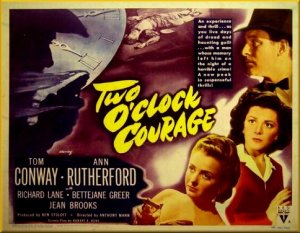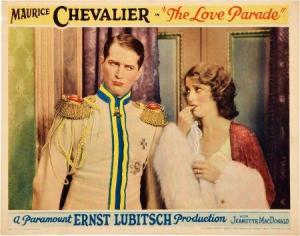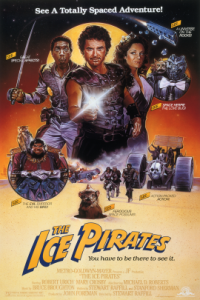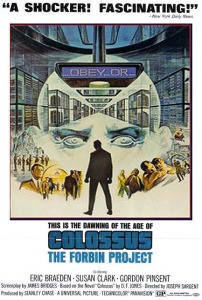“Two O’Clock Courage” (1945)
Emphasizing moral ambiguity is among the film noir’s cardinal tenets. This often takes the form of stories that have characters forging tenuous partnerships; whenever someone gets what they want, all bets are off as far as loyalties go. But then there are those flicks that favor a more literal approach, positioning their heroes as proto Leonard Shelbys by introducing straight memory loss to cloud whether they’re friend or fink. Although amnesia is a tricky narrative device to blitz past even the most forgiving cinephiles, 1945’s Two O’Clock Courage has no trouble doing just that, thanks to its breezy pacing and relatively lighthearted tone. It’s a slight shift in mood that may ruffle the feathers of folks who prefer their noir served black as pitch and with extra grit, but the end result is no genre betrayal by any stretch. Framing its thrills and close calls with a wicked sense of humor, Two O’Clock Courage comes through with an experience every bit as clever and tightly-constructed as its “serious” contemporaries.
The Man (Tom Conway) hasn’t a clue as to what sent him stumbling onto that street corner in the dead of night. Then again, no one is likely to recall much with a gash on their head, which — along with his kind face — is all that cab driver Patty Mitchell (Ann Rutherford) needs to take pity on the guy. But en route to the cops, the two catch wind of a theatrical producer’s murder…with someone fitting the Man’s description spotted hanging around the scene. Our amnesiac has no choice but to try putting together the pieces of an evening he can’t remember on his lonesome, and with only a matchbook, some ticket stubs, and $500 in his pockets, there isn’t much to go on. Fortunately, Patty believes wholeheartedly in his innocence, sticking close to the Man’s side as they bluff their way towards solving the mystery at hand before the authorities or whoever the killer might be catch up with them.
Released by Warner Archive under the Film Noir Collection banner, Two O’Clock Courage is less akin to Sam Spade than it is to Torchy Blane. There’s an uncommon pep at work here, giving the film the flavor of a screwball mystery that stands out amidst the hard-boiled thrillers of the era. The presence of this lighter attitude may turn off some viewers, as it entails putting broad humor and snappy lines at the forefront, rather than draping the proceedings in inky-dark photography. Despite this, however, Two O’Clock Courage tries much to do its mother genre proud. Director Anthony Mann (The Man from Laramie) uses the screenplay’s jovial nature to excuse the story’s more improbable patches, an act that yields surprisingly potent results. There’s a self-awareness to the scrapes that Conway’s character gets himself into, finding fun in how he has to navigate unexpected twists and revelations on a moment’s notice. Rutherford’s Patty is a fantastic companion for our befuddled protagonist, as her enthusiasm and appetite for danger pretty much just because she likes it proves infectiously fun. As the case frequently is with more typical films noir, many of Two O’Clock Courage‘s plot mechanics (involving back-stabbing, stage starlets, and a mysterious play with the same title) don’t matter as much as the overall mood and behavior of the characters do. What Mann lacks in a bleak worldview, he compensates for with a wickedly funny streak, entertaining us with wisecracks about murder and constantly depriving an over-zealous reporter (Richard Lane) of the scoop of the century.
Two O’Clock Courage takes itself seriously enough for the audience to want to see the main mystery resolved, though it has moments when it threatens to turn into a totally frivolous lark. The movie appropriately keeps us in the dark as to who and what the Man is for a healthy chunk of time, but little is done in the way of playing with our loyalty to the character. Conway’s perpetually bemused turn is a fun one and garners our sympathy rather fast, yet the story passes by several opportunities to insert him into situations or red herrings that may hint at a darkness we’re not totally privy to just yet. The running time of just an hour and change doesn’t leave much room to expand upon the gimmicky narrative hook, but Two O’Clock Courage nevertheless presses on and finds other avenues through which it can show folks a good time. The acting alone is spirited enough to carry just about any material, with Conway excelling at having to be a smooth-talker who really hasn’t a clue and Rutherford bubbling with energy as an amateur sleuth too caught up in things to want to let go. Also on hand is a fine stable of character actors delivering distinct supporting performances, from Lane as the frazzled reporter to Emory Parnell as a detective always two steps from blowing the Man’s cover.
Two O’Clock Courage still abides by certain film noir conventions, albeit in different ways that are nevertheless just as valid. As its aims aren’t to tsk-tsk the perils of greed or go on at length about what rotten bastards people can be, Mann doesn’t even allow these lofty ambitions to permeate the plot. Two O’Clock Courage takes what had already been played with for quite a while and would be further explored many times over and churns out a swift, engaging ride for its troubles.
(Two O’Clock Courage is available through the Warner Archive Collection.)










